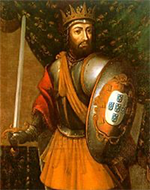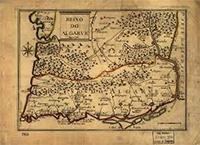King Afonso III of Portugal
Afonso III was King of Portugal for more than three decades in the 13th Century. 
He was born on May 5, 1210, in Coimbra, the capital. His father was Afonso II, and his mother was Urraca of Castile. When young Afonso was born, however, his grandfather, Sancho I was on the throne. Sancho I died in 1211, and Afonso II became king. He ruled for 12 years and then left the throne to Sancho II, the older brother of the young Afonso. Afonso went to France in 1228. He fought in the service of Louis IX, against England's Henry III. In 1238, Afonso married Countess Matilda II of Boulogne. That gave him the title of Count of Boulogne. Afonso II had come into conflict with the Catholic Church. That conflict escalated to the point that the pope had excommunicated King Afonso, and the king had then died. Sancho II had nominally agreed to make amends but then ended up precipitating the conflict, in the process alienating many nobles within Portugal. Eventually, a group of them implored Afonso, King of Boulogne to return to Portugal and replace his brother on the throne. Afonso agreed, and civil war raged for two years, from 1245 to 1247. Afonso's forces eventually prevailed, and Sancho fled to Toledo, in Castile. He died there, on Jan. 4, 1248. On that day, his brother became officially King Afonso III. The new king had learned the lessons that his older brother had not and went out of his way to keep the internal peace. He gave up all claims to Boulogne and, five years later, divorced Matilda, then marrying Beatrice of Castile, to cement the existing alliance with that Spanish kingdom, whose monarch was Alfonso X, Beatrice's father. Afonso and Beatrice had eight children, five of whom lived into adulthood: Blanche (1259), Dinis (1261), Afonso (1263), Sancha (1264), and Maria (1264). As well, Afonso kept in touch with the needs of his people, summoning the Cortes to Leiria in 1254 and insisting that its representation be relatively widespread. Among the results were laws to curb the nobility's ability to repress the poor and measures to prevent people from being arrested without proper cause. He also summoned the Cortes in Guimarães, in 1256 and 1261, and in Santarém, in 1273. 
Afonso III continued his predecessors' struggles to retake lands held by Moorish forces. He had great success in capturing Faro, in the Algarve; that victory brought that land into the kingdom. Castile, however, suddenly decided that it wanted the Algarve and, despite the fact that Portugal's queen was Castile's king's daughter, went to war. The two kingdoms fought over the Algarve for several years before the 1267 Treaty of Badajoz ended the conflict, setting the border as the Guadiana River. Although he had secured the support of most of his subjects and ended the war with Castile, Afonso still had an enemy in the Catholic Church, which insisted that it regain its authority in church-based courts and be allowed appoint its own bishops, two rights that the king had claimed for himself. Afonso had promised to do such things and generally obey the direction of the Church when he took the throne. Finally, in 1275, Pope Gregory X excommunicated Afonso. Other than that, Afonso III enjoyed a relatively peaceful sunset of his reign and died on Feb. 16, 1279, in Alcobaça. Succeeding him was his oldest son, who became King Dinis.
|
|
Social Studies for Kids
copyright 2002–2025
David White




